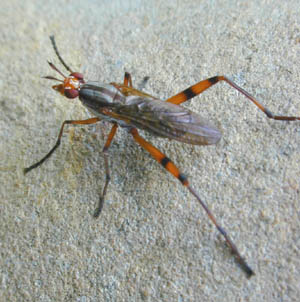
The Acalyptratae or Acalyptrata are a subsection of the Schizophora, which are a section of the order Diptera, the "true flies". In various contexts the Acalyptratae also are referred to informally as the acalyptrate muscoids, or acalyptrates, as opposed to the Calyptratae. All forms of the name refer to the lack of calypters in the members of this subsection of flies. An alternative name, Acalypterae is current, though in minority usage. It was first used by Pierre-Justin-Marie Macquart in 1835 for a section of his tribe Muscides; he used it to refer to all acalyptrates plus scathophagids and phorids, but excluding Conopidae.

Hypostomus is a genus of catfish in the family Loricariidae. They are native to tropical and subtropical South America. H. plecostomus is the popular freshwater aquarium fish formerly known as Plecostomus plecostomus. The taxonomic structure of the Loricariidae is still being expanded by scientists. Hypostomus is a highly species-rich and widely distributed catfish genus.

Dwarf snakehead is a term coined by aquarists to describe a group of Channa snakehead fishes growing to about 25 cm (10 in) maximum. They are found in freshwater habitats in South and Southeast Asia, and southern China.
Cândido Firmino de Mello-Leitão was a Brazilian zoologist who is considered the founder of Arachnology in South America, publishing 198 papers on the taxonomy of Arachnida. He was also involved with education, writing high-school textbooks, and contributed to biogeography, with essays on the distribution of Arachnida in the South American continent.

The banded bullfrog is a species of frog in the narrow-mouthed frog family Microhylidae. Native to Southeast Asia, it is also known as the Asian painted frog, digging frog, Malaysian bullfrog, common Asian frog, and painted balloon frog. In the pet trade, it is sometimes called the chubby frog. Adults measure 5.4 to 7.5 cm and have a dark brown back with stripes that vary from copper-brown to salmon pink.
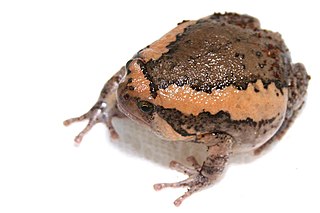
Kaloula is a genus of microhylid frogs found in southern and eastern Asia. They are sometimes known as the Asian narrowmouth toads.

Tetrigidae is an ancient family in the order Orthoptera, which also includes similar families such as crickets, grasshoppers, and their allies. Species within the Tetrigidae are variously called groundhoppers, pygmy grasshoppers, pygmy devils or "grouse locusts".

Grammostola pulchra is a species of tarantula, native to Brazil. It is known for its solid black body, which makes it an appealing tarantula for the pet trade.

Leopoldinia is a mostly monoecious genus of flowering plant in the palm family from northern South America, where they are known as jará palm or pissava palm. The two known species are commercially important, especially L. piassaba, which yields sustenance and construction material. The genus is named for Maria Leopoldina, archduchess of Austria, and Brazilian empress.
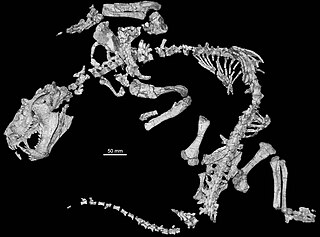
Trucidocynodon is an extinct genus of ecteniniid cynodonts from the Upper Triassic (Carnian) of Brazil. It contains a single species, Trucidocynodon riograndensis. Fossils of Trucidocynodon were discovered in outcrops of the Upper Santa Maria Formation in Paleorrota Geopark, Agudo. Trucidocynodon is one of the most completely known Triassic cynodonts, as its holotype is a nearly complete and fully articulated skeleton.

Timia is a genus of flies in the family Ulidiidae, which is difficult to separate from the genus Ulidia.
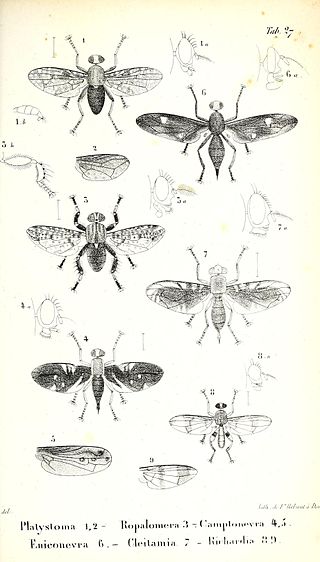
The Ropalomeridae are a family of acalyptrate flies.
Scrobipalpa pulchra is a moth of the family Gelechiidae. It is found in Latvia, Russia, Ukraine, the Near East and Middle East, Turkey, Central Asia, Mongolia and China (Xinjiang).
Arulenus miae is a species of pygmy grasshopper which is found on the island Mindanao in the Philippines. It was described in 2016 by Josip Skejo and Joy Honezza S. Caballero. They became aware of the species' existence through a photograph posted to a Facebook group. Specimens were later collected from Bukidnon Province. It is named in honor of a friend of Skejo, named Mia.
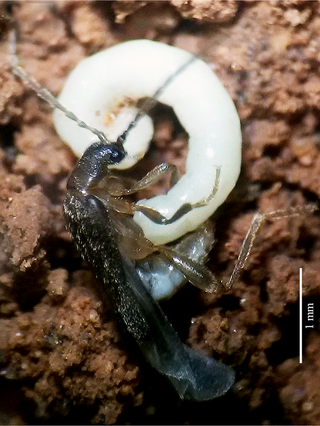
Jurasaidae is a family of elateroid beetles known from around a half-dozen species in two genera found the Brazilian Atlantic rainforest including drier transitional areas bordering the Caatinga. All known species have neotenic larva-like females and normal males, similar to some other elateroids. They occur in the soil horizon immediately under leaf litter, with the larvae likely being fungivorous, consuming the fluids of fungal hyphae.

Arrudatitan is an extinct genus of titanosaur sauropod dinosaur known from the Late Cretaceous (Campanian-Maastrichtian)-aged Adamantina Formation of Brazil. The type species, A. maximus, was named and described in 2011 as a species of Aeolosaurus, but was separated into its own genus in 2021. It was relatively gracile for a titanosaur.
Acrocephalomyia is a genus of flies in the family Ropalomeridae. It contains three recognized species.
Acrocephalomyia torulosa is a species of fly in the genus Acrocephalomyia of the family Ropalomeridae.
Acrocephalomyia zumbadoi is a species of fly in the genus Acrocephalomyia of the family Ropalomeridae.
Ghatiana pulchra is a species of freshwater crab from the northern Western Ghats in India that was first identified in 2018.











